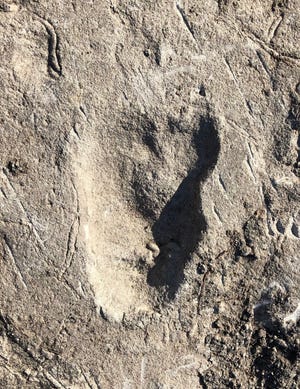
A set of footprints found in the east African country of Tanzania from millions of years ago have long been thought to belong to a bear, but researchers have discovered they actually belonged to an ancient human species, suggesting there may have been more than one early human species existing at the same time.
The area of Laetoli in northern Tanzania is known for having fossils dating back millions of years. One site, Laetoli site G, is where the fossils of the Australopithecus afarensis have been recovered, widely regarded as one of the earliest human species walking on two legs. The famous skeleton of "Lucy" from 3.18 million years ago was part of the Australopithecus afarensis species.
However, not far from Laetoli site G, Laetoli site A had a set of footprints that appeared to be much wider than Australopithecus afarensis footprints. The prints, discovered in the 1970s, were thought to be a bear because they didn't resemble any known human species.

Ellison McNutt, an assistant professor at the Heritage College of Osteopathic Medicine at Ohio University, took interest in the "mysterious" prints because she didn't believe they belonged to a bear. McNutt's interest is understanding the evolution of human walking and why it's done on two legs.
McNutt went to a local bear sanctuary and had bears there make prints so she could compare them with the ones from Laetoli site A. The two didn't match.
"It's not consistent with a bear, and it doesn't appear to be consistent either with what we see in site G, which are the ones that belong to afarensis. So it seems to be a little bit more of a primitive foot," McNutt told USA TODAY.
The lead author of the peer-reviewed study published in the journal Nature on Wednesday explained what makes it appear to come from a hominin – the ancestors of humans – is because of the cross stepping the prints indicate. When bears or chimpanzees attempt to cross step, it would have to be on one leg. They waddle when doing so, and cannot cross step like a model on a runway or someone trying to maintain balance.
As hominins began to evolve, hip muscles and the positioning of the knee allowed them to not only walk on two legs, but to maintain enough balance to cross step. The steps also included impressions for a heel and a big toe.
"That's how we know for sure that, one way or another, this belongs to an individual within our lineage," McNutt said.

The team of international researchers studying the prints with McNutt came to the conclusion that although the prints are wider than the ones at site A, they most likely came from a juvenile hominin, and even full grown adults were not as big as most humans today.
Unlike "Lucy," the team isn't exactly sure when these prints were made, but analysis of it gave it a thousand year range around 3.66 million years ago. What they find remarkable is that time frame overlaps with when the Australopithecus afarensis were also roaming around.
"It's very possible that the individual who made Laetoli A could have kind of looked up across the landscape and seen an Australopithecus afarensis walking by," McNutt said. "It kind of tells us that we used to not be alone, and that our family tree used to be a lot fuller and more diverse. There wasn't just kind of one single way of being human."
Ancient hangover cure? This ring may have been used to avoid effects of drinking too much
More: Researchers announce discovery of ancient mammoth tusk found 10,000 feet deep in the ocean
Jeremy DeSilva, senior author and associate professor of anthropology at Dartmouth College, said there still are a lot of questions of how humans began walking on two feet, and the findings only complicate the evolution of it since there were two different hominins.
McNutt added the hope is to find more of these prints to better understand not only their movement, but the size of them.
Contributing: Taylor Avery, USA TODAY
Follow Jordan Mendoza on Twitter: @jordan_mendoza5.









